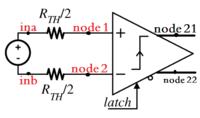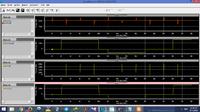canarybird33
Member level 1
- Joined
- Apr 16, 2013
- Messages
- 41
- Helped
- 2
- Reputation
- 4
- Reaction score
- 2
- Trophy points
- 1,288
- Location
- Mashhad, Iran, Iran
- Activity points
- 1,591
Hello all,
In my searches,the below method is used to calculate kickback noise.(Rth=8kohm; according to the this paper "Kickback Noise Reduction Techniques for CMOS Latched Comparators"]

My simulation doesn't show sensible results. I mean, when I apply this method, the comparator does not work properly. the simulatin results are as follows (Node 21 and Node 22 are outputs):

My questions are:
should the comparator work as normal when calculating kickback noise?
Is the Rth=8kohm a general rule? Why 8k?
How should I apply the ina and inb as inputs?(I have applied 2 separate pulse to create the signal as same as the paper I mentioned above)
Thanks.
In my searches,the below method is used to calculate kickback noise.(Rth=8kohm; according to the this paper "Kickback Noise Reduction Techniques for CMOS Latched Comparators"]

My simulation doesn't show sensible results. I mean, when I apply this method, the comparator does not work properly. the simulatin results are as follows (Node 21 and Node 22 are outputs):

My questions are:
should the comparator work as normal when calculating kickback noise?
Is the Rth=8kohm a general rule? Why 8k?
How should I apply the ina and inb as inputs?(I have applied 2 separate pulse to create the signal as same as the paper I mentioned above)
Thanks.
Last edited:
